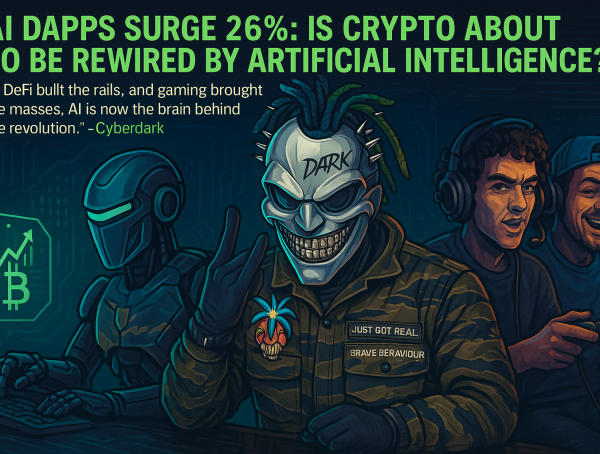Central banks are cooking something. Again. They call it CBDC — Central Bank Digital Currency. But to me, it smells like centralized control under the sleek disguise of innovation. If this sounds like a dystopian script where banks impersonate software developers and your wallet doubles as a tracking device, that’s because it is.
And let’s be honest: I’ve seen this reboot before. Just like your favorite sci-fi franchise, the Machine Takeover always starts slow, in lab coats and boardrooms. But this isn’t Skynet. It’s much worse — it’s Skynet with Terms of Service.
Money Rewritten in Code — But Who Holds the Pen?
The Central Bank of Russia just dropped new numbers: 988 active issues of ЦФА (digital financial assets) now infest their “information systems,” while overall volume dropped 35.9% this quarter. That’s about 174 billion rubles exchanging digital hands — a number that should shock you until you realize what it represents:
Synthetic finance, coded and controlled not by cryptography’s rebellious spirit, but by state-mandated ledgers.
Globally, the CBDC drumbeat is getting louder. An OMFIF report (read: “global banker gossip”) shows that 75% of central banks are preparing for a retail CBDC rollout. Some aim to deploy within 3–5 years. Others are still caught up in bureaucracy, debating whitepaper formats like it’s 2011 and Bitcoin just got out of diapers.
But make no mistake: CBDCs are not about tech. They’re about control.
“Programmable” Money: Your Freedom, Version 1.0 (Beta)
CBDCs offer everything a modern digital authoritarian could dream of:
- Programmable payments: Governments can define where, when, and how your money is spent.
- Offline tracking: Thanks to “progress” in offline payments, you can now be watched even when disconnected.
- Total visibility: Every transaction, forever. Just in case you had rebellious thoughts about financial privacy.
One analyst framed this as a benefit: “It provides a shared innovation platform with public data traceability.”
Translation: We’ll innovate with your money, and watch everything you do with it.
The Financial Sector’s Midlife Crisis
You see, central banks never liked the fact that DeFi, crypto, and stablecoins pulled the rug from under them. They’ve spent the last decade trying to “catch up,” except they skipped the philosophy of decentralization and only kept the aesthetic. Blockchain buzzwords? Check. Sandboxed pilot apps? Check. But real trustless finance? Nowhere to be found.
In fact, countries like the U.S. under Trump even banned the idea outright in January 2025. Ironically, that may have been the most pro-freedom move to date.
Meanwhile, emerging markets are pushing hard — not for freedom, but for digital sovereignty. According to Mind Money’s own Yulia Khandoshko, 20% of central banks in developing markets are planning digital bonds within two years.
Why the rush? Because the developed world already has Stripe, Apple Pay, PayPal, and dozens of fintechs that outperform central banks. In countries without that infrastructure, CBDC looks like innovation. In reality, it’s just digital duct tape on top of broken systems.
Rise of the Bureaucratic Cyborgs
Let’s step back.
Imagine a world where your bank account auto-adjusts after every government press conference. Where your paycheck expires if not spent on “approved services.” Where you can’t send money to your whistleblower friend because an algorithm flagged your chat as “misaligned with social stability protocols.”
Sound wild? That’s the endgame of programmable CBDC.
Don’t believe me? The tech is already here:
- Offline CBDC transaction protocols? ✅
- Identity-linked wallets? ✅
- Central bank kill-switches? You bet.
And the worst part? This isn’t a secret. It’s all wrapped in “UX optimization” language. The same UX they now claim is “the hardest part of CBDC implementation.” Not transparency. Not consent. Just… design polish.
The New Economic Surveillance Stack
The rise of CBDC isn’t just financial — it’s architectural. It’s layered infrastructure for surveillance capitalism baked into the core of monetary systems:
- Layer 0: Central banks.
- Layer 1: Licensed platforms like Atomyze, Lighthouse, or Sberbank’s token machine.
- Layer 2: Programmable APIs — monetizable restrictions, real-time taxation, algorithmic fines.
- Layer 3: You — watching it all unfold from your digital cage, now with stickers.
And remember, every layer leaks. Every node can be compromised. But there’s no rollback here. No “oops” function on government-ledgers.
The system isn’t built for you to understand it. It’s built so you can’t.
So What Can We Do?
We ask the uncomfortable questions:
- Why are we reinventing money without reinventing trust?
- Why do we keep building infrastructure that assumes the citizen is guilty?
- Why is every “next-gen” financial tool wrapped in coercive oversight?
The cyberpunk answer? Fight fire with fire:
- Use privacy coins.
- Run nodes.
- Exit fiat where possible.
- Demand open-source audits of every layer.
- And never stop asking who holds the keys — and why.
Because while CBDC is framed as a technical upgrade, it’s a political downgrade. A downgrade in autonomy, in anonymity, and in freedom of economic movement.
Final Transmission from CyberDark
CBDC is not a tool. It’s an operating system for society.
One where the state becomes your payment processor, your accountant, and your financial conscience.
We’ve already seen what happens when platforms like Telegram, with no oversight, become scam heavens. Now imagine that logic — but applied to your salary. Your savings. Your life.
If this is the future, then I’m grabbing my diamond-encrusted keyboard and heading back to the underground. The revolution may not be televised — but it’ll be encrypted.
Stay sharp. Stay sovereign.
— CyberDark
You might also like
More from Crypto
93+ Billion Stolen Cookies Swarm the Dark Web
In an era where digital identities are the new currency, a new shadow economy is booming underground. According to a …
Dark Web Files: Coinbase Hacker Flexes $42.5M THORChain Swap, Trolls ZachXBT Like a True Cyber Ghost
Yo, the shadow game's heating up again—straight outta the darknet trenches. Remember that savage breach at Coinbase back in late …






















